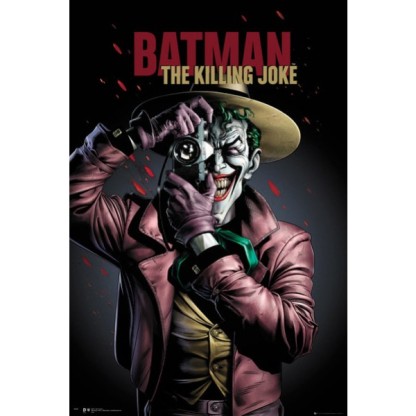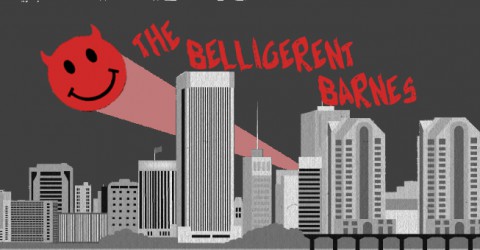If you ask many longtime fans what was the first (memorable) Batman title they ever read was, the answer will most likely be Alan Moore’s legendary one-shot, The Killing Joke. It’s sort of ironic that an entire generation of Batman fandom associates the beginning of their Dark Knight love with one of the character’s darkest literary titles.
The Killing Joke has remained one of the most divisive comics to this day; the kind of book that takes on different meaning during repeated readings set years apart. I read the book as a kid and was captivated while still protected by rightful naiveté. Ten years later, I reread the book to find equal parts captivation and anxiety as its previously unrealized deeper themes came into my realization. Now, as a father, I read the book again and experienced the full horror that had blissfully alluded me in the years past. Anyone who dismisses the literary power of comic books is missing out – Alan Moore has proven that time and time again.
Twenty-eight years after its release, we’re finally able to see the property adapted for film. DC Comics has an unparalleled average with its animated films so it was the best possible outlet for Moore’s work to be brought to life. News that the supreme talents of Kevin Conroy and Mark Hamill would be used to voice Batman and the Joker, respectively, meant that the movie would be done right. Topping everything off, they allowed it to be Rated R so there would be no diluting of the source material. I bought my wife and I tickets for the one night Fathom Events screening mere hours after they became available for presale.
So how was it? Here’s your obligatory “spoiler warning” (which should be unnecessary for this specific title)…
Batman: The Killing Joke – directed by Sam Liu

The film starts out by showing a short interview with Mark Hamill. He discusses his past and what led him to become the iconic voice of one of the most iconic comic book characters. It was fascinating to hear his direct take on it; how he wanted to be involved with Batman: The Animated Series in any role BUT the Joker. He felt that a character like Luke Skywalker couldn’t have any association with the depravity of the Joker. We’re all so fortunate that he decided to do it anyway! Hamill’s segment was an unexpected way to begin the movie which also turned out to be perfect. It was a unique way to incite excitement then segue into the actual film.
Much of the criticism I’ve read about the movie is directed towards its first act which centered around Batgirl. The fact of the matter is, Alan Moore’s novel is only 48 pages long – a third of the length of your average graphic novel. They had to add a significant amount of material in order to not only adapt the story properly, but to also make it long enough to warrant production. Batgirl’s story acts as a framing device that helps tie everything together while setting the emotional stakes appropriately for what was to come. It also contributes to what I feel was the overall theme (something I’ll get to in a moment). It threw me off when Batman and Batgirl bumped vigilante uglies under the voyeuristic eyes of a stone gargoyle, but not to the extent that I thought anything less of the movie. If anything, the scene emphasized the fact that there are still people under the cape and cowl. Plus – Batgirl is a hot, kick ass librarian… can you blame Batman for giving into the moment? Some of the more vocal critics have focused on this scene for the wrong reasons, in my humble opinion. Batgirl isn’t just a jilted lover but rather she’s undergoing a transformation in line with the theme (again, I’ll get to that). Tara Strong’s voice acting definitely sells the emotional uneasiness that reverberated as a result of the rooftop scene. If you focus on the relatable humanity of the scenario then it’s easy to overlook the strength of character she forges as a result of everything that occurs.
The rest of the movie follows very closely with the novel. It doesn’t spare the audience from any of the depraved brutality of the source. Kevin Conroy and Mark Hamill’s vocal chemistry is just as powerful now as it was back in 1992 during “Joker’s Favor” (the first aired B:TAS episode featuring the two titans). You can hear the age in both actor’s voices which contributed to the grizzled dread that is so palpable in the original work. I absolutely loved additions made to the dialogue like the twistedly funny librarian puns made by the Joker standing over Batgirl’s wounded form. I will never tire of the Hamill/Conroy team up. I’ve heard their voices in my head with every comic appearance for as long as I can remember. One day I’d love to meet the actors because they both seem like the nicest guys around.
The Killing Joke’s underlying theme is about a person’s breaking point. When you’ve hit your lowest moment, the ultimate “bad day”, what direction will you take? What will you become after being taken beyond the brink? Batman and Joker are presented as both opposites and equals. They were each taken to that point then returned on completely opposite terms. We all know Batman’s story (thank god they didn’t feel the need to show any of it like every other Batman adaptation seems to) so seeing the Joker’s past was extra captivating. Personally, I prefer the vague approach Christopher Nolan later took with the Joker: his rabid unpredictability and untraceable origin makes him all the more terrifying. With that said, I cannot deny that the scene when Joker emerges from the chemicals and sees his reflection is powerful. I think I got chills hearing the transformation taking place with Mark Hamill’s haunting Joker cackle scoring the shattering of a man. An origin story for Joker was necessary to show the other extreme that could happen when that ultimate bad day occurs.
This story isn’t just a Batman/Joker story, it’s also a Batgirl and Commissioner Gordon story. Perhaps that’s what the negative critics are missing. If you look at the movie as only a Batman tale, then Batgirl does indeed become wrongly objectified and weak overall. Barbara Gordon’s story frames the entire film because it starts with her at her best, leads her along the edge of a disturbing abyss, before allowing her to emerge strong and confident regardless of what horrors she experienced. Commissioner Gordon’s side is the least developed yet still important since he’s the one to directly prove the Joker wrong by desiring to go “by the book” rather than embracing the laughable insanity craved by Joker.
The ending did slightly vary from the graphic novel… At first I didn’t like the difference but have since pondered the change and think it was the best route they could have taken. In the book, Batman shares a laugh with his equally mad counterpart then seemingly kills him. This works for the book but would have felt somewhat disjointed for the movie. After stressing the theme of returning from that breaking point, it wouldn’t have been right for the film to immediately go the other way by having Batman stoop to the Joker’s level. They openly acknowledge that the end of their story is clear: one of them will end up killing the other. Yet it’s Batman who chooses to take the route of redemption with an open offer for Joker to work with him in search of an end to the madness. He believes that their story doesn’t have to end that way; insanity doesn’t need to be all that remains when all is lost. The final scene with Barbara Gordon becoming Oracle further contributes to this thinking while bringing everything full circle. It was a far more defined ending than that of the book.
So don’t let the critics determine your own personal opinion of it. Watch the film and look beyond the surface to the expansive past that a wealth of source material has granted the characters on screen. There is much more present in this tale than just victims and villains. The Killing Joke is a raw, worthy adaptation of a milestone in comic history that features talented art direction and legendary voice acting.
My rating of Batman: The Killing Joke is 8 out of 10.

Leave a comment
No comments yet.

Leave a comment